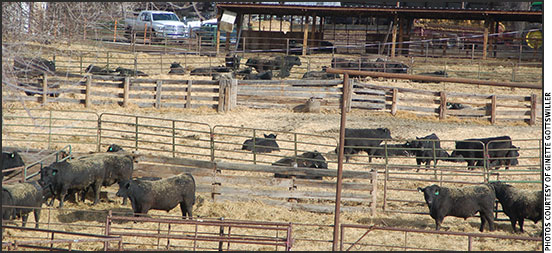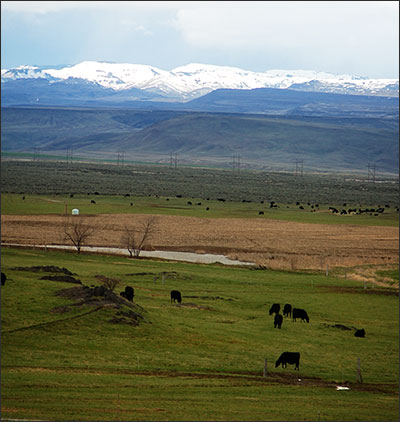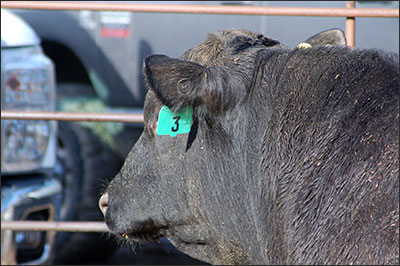

Ginette Gottswiller
The Source
Make bull buying easier with a plan.
Buying bulls can be a dreaded chore for some cattlemen, while others actually enjoy the hunt to find the best bull at the best price.
During a recent bull sale at Spring Cove Ranch, it appeared bull buyers did not dread being there at all. The Butler family pulled out all the stops to make sure their potential buyers were well-fed and well-educated. They invited me to talk one on one with commercial producers about the benefits AngusSource® and quality Angus genetics can offer.
Ask a producer what they don’t like about going bull shopping and you will hear a variety of reasons. Bulls are expensive! … I can’t find a bull that can do it all for the price I want to pay. … What do all these numbers mean? … Why are all the expected progeny differences (EPDs) different in every bull sale book?

I understand why bull buying can be stressful. So, how can you alleviate that stress? First, decide how many bulls you need to purchase, then what you want each bull to accomplish. Do you have a roadmap and some attainable goals set so you can assign some basic shopping criteria to your selections?
Making a plan
Let’s look at an example herd. Mr. Commercial Producer started out with some crossbred cows of varying breeds. Year after year he purchased registered-Angus bulls from the neighbor that didn’t cost much. They were alive, had four feet, and he didn’t even look at the EPDs. Over the years he noticed his replacement heifers were getting smaller and his weaning weights were, too.
Mr. Commercial Producer decided it was time for a change. He called the American Angus Association to discuss his situation with the director of commercial programs. We looked through some past receipts and charted his weaning weights. Then we looked at the weaning weight and milk EPDs on the bulls he was using. This producer indicated he thought his cows were drying up before he weaned his calves.
He had been supplementing the calves with creep feed the last couple of years to sell calves that averaged 520 pounds (lb.) at weaning. His average milk EPD on the bulls he had purchased during the past eight years was +12, and the average weaning weight EPD was +29. A historical look indicated that in 1996 the genetic trend for weaning weight was +25 and for milk was +12. Mr. Commercial Producer was using bulls that were average for these two traits 20 years ago.
We made charts to better track weaning weights using the Association’s genetic trend table. Upon further study, this producer decided it was time to purchase bulls with a higher milk EPD, higher weaning weight EPD and set a minimum docility EPD. Calving ease was also important to him, because he had not pulled any calves other than abnormal presentations for the past five years. He wanted to continue to look for calving-ease bulls.
I showed him the table for percentile breakdown of EPDs for current sire and non-parent sires. He chose to look for a +54 weaning weight EPD, +26 milk EPD and a +17 docility EPD. In addition, it is always important to remember to study the accuracy of EPDs. Look to see if the bull had been DNA-tested to give that accuracy a boost.
Mr. Commercial Producer set some goals and criteria for bull selection. He has a plan for bull-buying season.
Put the plan in action
Now it was time to request sale books. I like to highlight and color code the bulls that meet the criteria for purchase. Phenotype is very important, too. Visit the seedstock producer in advance of the sale. Look over the bulls you have selected. Make sure to note any bull you do not want to buy. Even though that bull may have the best numbers, if you don’t like how he walks, you are not going to like him any better when you get him home.

This example has been distilled down to the basics, but the basics are great building blocks to get started. There are $Value indexes that can also be used as selection tools. However, first get comfortable with the numbers and know what these indexes are designed to do for you. Keep records on your herd to determine where you are and where you need to go. Look at your herd data each year to determine if you have made progress. Progress means economic gain!
The American Angus Association’s AngusSource program uses the average EPDs on the Marketing Document and Verification Certificate for each calf crop you enroll. Many producers try to improve their EPDs on that document each year. When they sell a bull, they replace that bull with one that has improved EPDs. When completed, this Marketing Document is emailed to more than 600 potential buyers. Who wants to send out a document that doesn’t have some great numbers in the boxes?
Isn’t it time you get paid what your Angus-sired calves are worth? AngusSource is a cost-effective marketing program that verifies the Angus genetics used for your enrolled calf crop, group age and source. Many people think there isn’t a reason to enroll in an age- and source-verification program any longer. They’re wrong.
Last year calves enrolled in an age-verified program selling on a major video auction averaged $4.07 more per hundredweight (cwt.) than non-enrolled calves. Buyers look for cattle that have the extra bells and whistles, plus they want to know what Angus sires were used.
Contact your area regional manager or call the Commercial Programs Department at the American Angus Association to learn more about how you can enroll in AngusSource to improve your breeding program and your bottom line.
 Editor's Note: Ginette Gottswiller is the director of commercial programs for the American Angus Association.
Editor's Note: Ginette Gottswiller is the director of commercial programs for the American Angus Association.
[Click here to go to the top of the page.]






